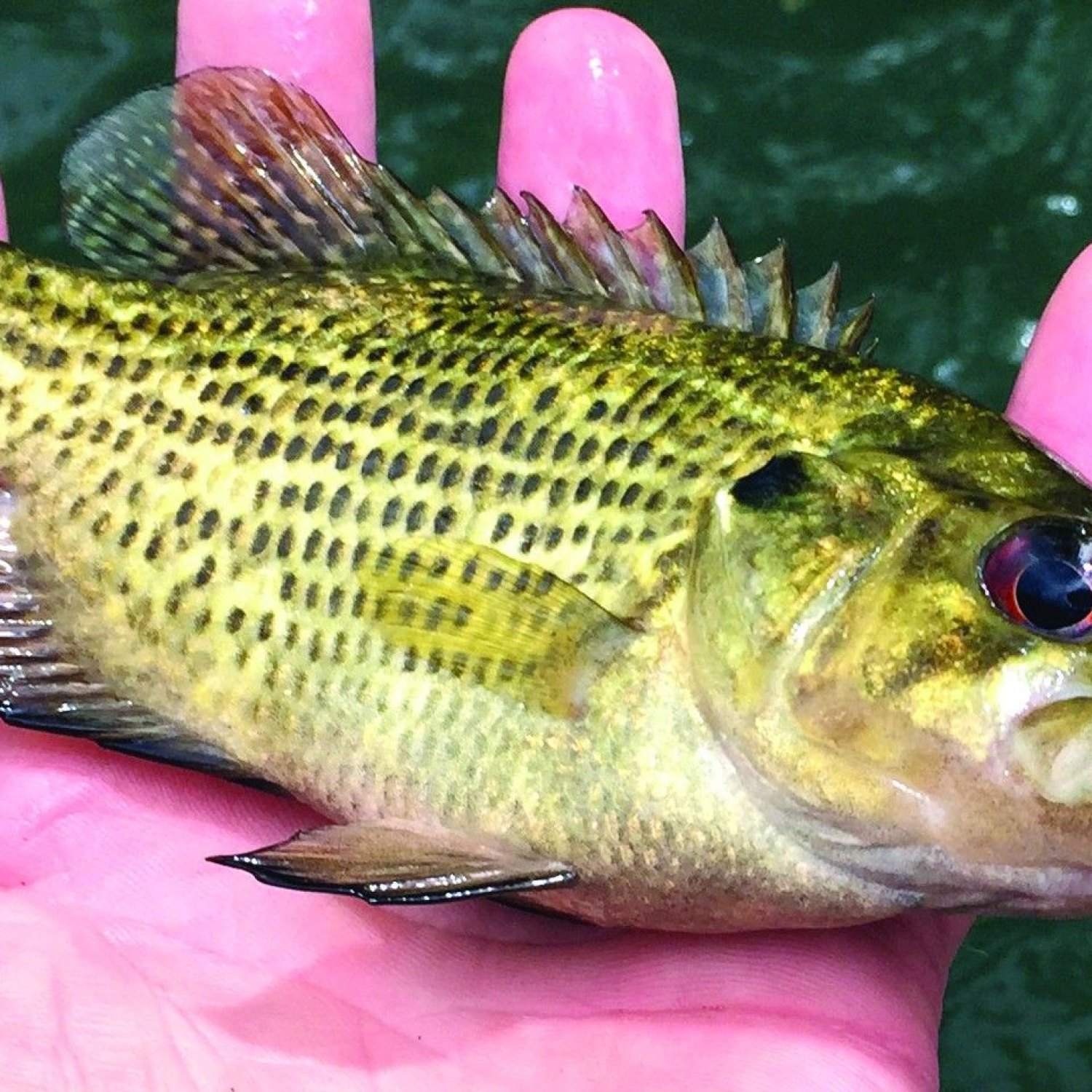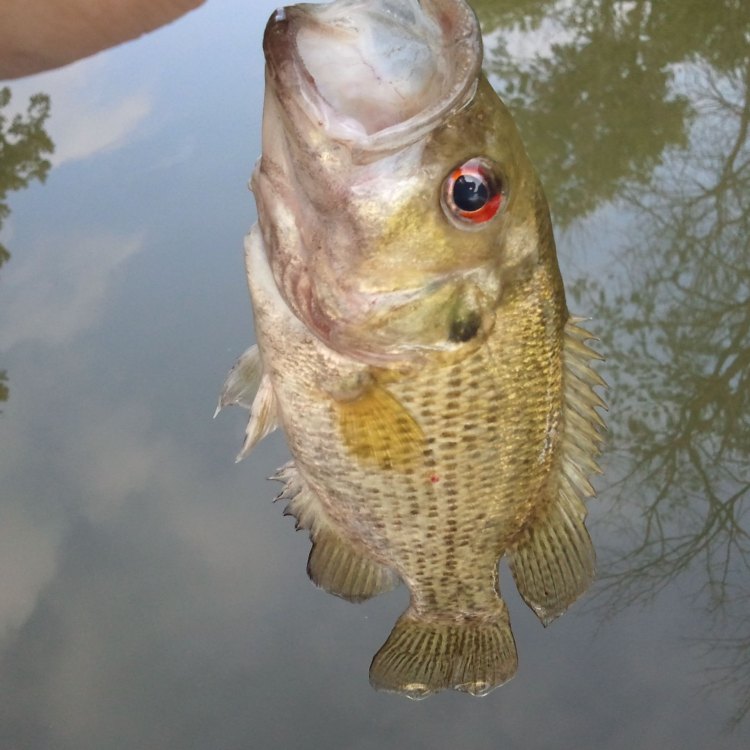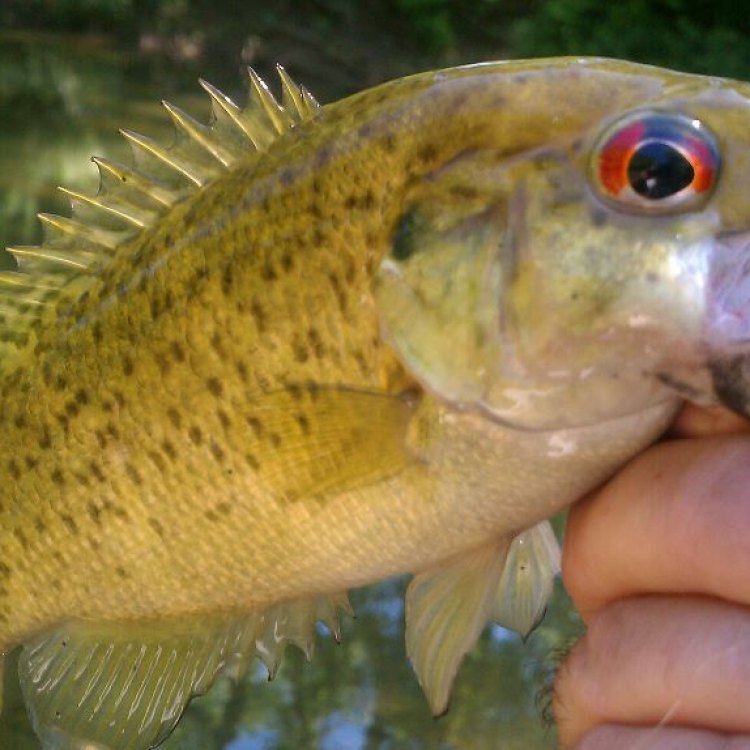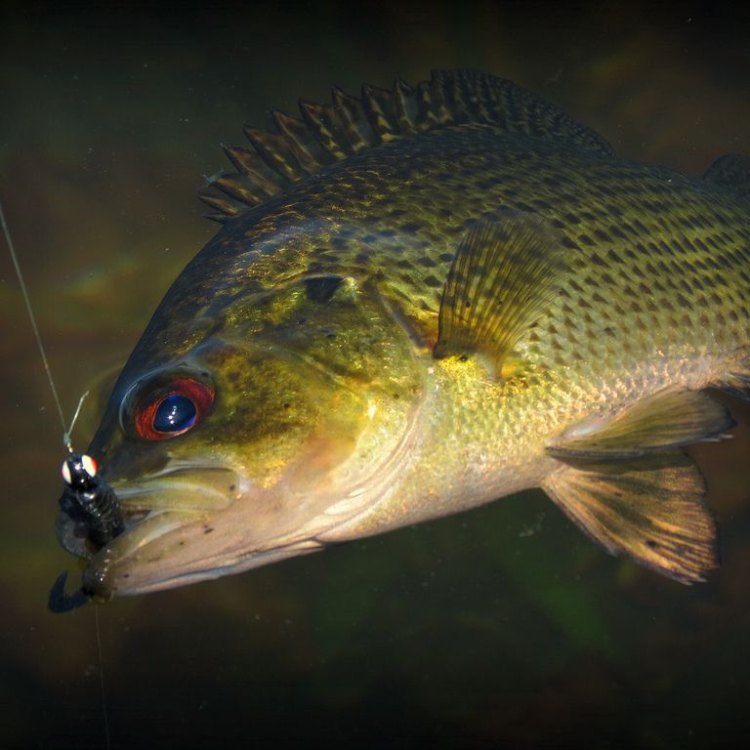
Rock Bass
6-10 inches
The Rock Bass, also known as the Ambloplites rupestris, is a popular freshwater fish found in rivers, streams, and lakes. Its deep-bodied shape makes it a formidable predator, able to swiftly swim and catch its prey. With an average length of 6-10 inches, this member of the Centrarchidae family is a favorite catch among anglers. #RockBass #FreshwaterFish #FishingFun #Centrarchidae
Animal Details Summary:
Common Name: Rock Bass
Kingdom: Animalia
Habitat: Freshwater
The Rock Bass: A Hidden Gem of North America's Freshwater Habitats
The beautiful and elusive Rock Bass, known scientifically as Ambloplites rupestris, is a hidden gem of the freshwater habitats of North America. While not as well-known as its piscine counterparts such as the bass or perch, the Rock Bass boasts a unique set of characteristics and adaptations that make it not only a fascinating species but also an important player in the ecosystem.Kingdom and Phylum: The Classification of the Rock Bass
The Rock Bass belongs to the kingdom Animalia and the phylum Chordata. This classification means that the Rock Bass has a backbone and is capable of locomotion, making it a true vertebrate animal Rock Bass.Class, Order, and Family: Actinopterygii, Perciformes, and Centrarchidae
The Rock Bass belongs to the class Actinopterygii, also known as ray-finned fishes, which includes more than 30,000 species. Within this class, the Rock Bass falls under the order Perciformes, which refers to perch-like fishes. Finally, the Rock Bass is a member of the family Centrarchidae, which includes other popular sportfish such as the Largemouth Bass and the Bluegill.Habitat: A Life in Freshwater
The Rock Bass is primarily a freshwater fish and can be found in various bodies of water, including rivers, streams, and lakes. Its preference for clear, cool waters with plenty of cover has earned it the nickname "rock perch" due to its presence near rocky areas.Feeding Method: Carnivorous Diet
As a carnivorous species, the Rock Bass feeds on a variety of prey, including small crustaceans, insects, and other fish. It uses its sharp teeth and quick reflexes to catch its food, and its streamlined shape allows it to maneuver through the water with ease.Geographical Distribution: Found Across North America
The Rock Bass is native to North America and can be found across the continent, from southern Canada to the Gulf of Mexico. Within its range, it has a preference for the central region of the United States, where it is most abundant Red Aphids.Country of Origin: A Proud Member of the United States' Fauna
The Rock Bass has its roots in the United States and can be found in various states, including California, Illinois, Ohio, and Virginia. Its ability to thrive in different habitats and tolerate a wide range of environmental conditions has made it a beloved resident of the country's freshwater environments.Location: Rivers, Streams, and Lakes
The Rock Bass can be found in a variety of freshwater habitats, but it prefers the slower-moving waters of rivers, streams, and lakes. Within these environments, it tends to seek out areas with plentiful cover, such as submerged logs and rocky crevices.Animal Coloration: Olive-Brown to Bronze
The Rock Bass's coloration varies depending on its age and habitat, but it typically ranges from an olive-brown to a bronze hue. This coloration helps it camouflage with its surroundings, making it less visible to both potential prey and predators.Body Shape: A Deep-Bodied Fish with Unique Adaptations
One of the most striking features of the Rock Bass is its deep-bodied shape. This adaptation allows it to hide in crevices and openings in rocky areas, making it difficult for predators to catch it. It also has small yet sharp spines on its gill covers and dorsal fin, providing an extra layer of protection.Length: A Small But Mighty Fish
Despite its small size, the Rock Bass can grow up to 6-10 inches in length, which is relatively large compared to other freshwater species. This gives it an advantage in competition for food and helps it avoid being preyed upon by larger fish.The Vital Role of the Rock Bass in the Ecosystem
The Rock Bass may not be the most popular fish in North America, but it plays a vital role in the ecosystem. As a predator, it helps keep the population of smaller fish and invertebrates in check, preventing overpopulation and maintaining a healthy balance in the food chain. Its ability to adapt and thrive in various habitats also makes it a crucial component of the ecosystem, contributing to the overall diversity of freshwater species.The Rise of the Rock Bass in Sport Fishing
In recent years, the Rock Bass has gained recognition as a sportfish, attracting anglers with its unique characteristics and challenging fishing techniques. With its sharp teeth and powerful fight, the Rock Bass has become a sought-after target for recreational fishing in North America's freshwater habitats.Threats to the Rock Bass Population
Despite its resilience and adaptability, the Rock Bass population faces various threats. Habitat destruction and pollution are significant factors that can impact the species' survival. Additionally, overfishing and the introduction of non-native species can also disrupt the balance of the ecosystem and negatively impact Rock Bass populations.In Conclusion: A Fish Worth Knowing
The Rock Bass may not be the most famous fish in North America, but its unique set of characteristics and important role in the ecosystem make it a species worth getting to know. Its deep-bodied shape, olive-brown coloration, and sharp teeth are just some of the features that make it a fascinating creature to observe. Whether you're an avid angler or simply a nature enthusiast, the Rock Bass is a hidden gem of the freshwater habitats of North America that's worth discovering.

Rock Bass
Animal Details Rock Bass - Scientific Name: Ambloplites rupestris
- Category: Animals R
- Scientific Name: Ambloplites rupestris
- Common Name: Rock Bass
- Kingdom: Animalia
- Phylum: Chordata
- Class: Actinopterygii
- Order: Perciformes
- Family: Centrarchidae
- Habitat: Freshwater
- Feeding Method: Carnivorous
- Geographical Distribution: North America
- Country of Origin: United States
- Location: Rivers, streams, and lakes
- Animal Coloration: Olive-brown to bronze
- Body Shape: Deep-bodied
- Length: 6-10 inches

Rock Bass
- Adult Size: 6-10 inches
- Average Lifespan: 6-8 years
- Reproduction: Egg-laying
- Reproductive Behavior: Monogamous
- Sound or Call: Produces grunting sounds
- Migration Pattern: Non-migratory
- Social Groups: Solitary
- Behavior: Aggressive when defending territory
- Threats: Habitat loss, pollution, overfishing
- Conservation Status: Least Concern
- Impact on Ecosystem: Important prey species
- Human Use: Recreational fishing
- Distinctive Features: Red eyes, dark lateral band
- Interesting Facts: Can tolerate a wide range of water conditions
- Predator: Larger fish, birds of prey

Ambloplites rupestris
The Fascinating World of the Rock Bass: A Small But Mighty Fish
When it comes to the vast and diverse underwater world, there are countless species of fish inhabiting our oceans, lakes, and rivers. From massive whales to tiny seahorses, each creature plays a vital role in maintaining a balanced ecosystem. However, there are some species that tend to be overlooked by the average person, such as the rock bass. This small yet mighty fish has many unique features and behaviors that make it a fascinating species to study PeaceOfAnimals.Com. In this article, we will dive deeper into the world of the rock bass and explore its distinctive traits, threats, and importance in the ecosystem.Size, Lifespan, and Reproduction
The rock bass, also known as the Ambloplites rupestris, is a freshwater species of fish that can be found in the eastern and central regions of North America. They are a species of the sunfish family, which includes other popular sport fishes such as largemouth bass and bluegill. Rock bass are known for their relatively small size, typically ranging from 6 to 10 inches as adults. However, their size does not reflect their lifespan, as they can live up to 6-8 years, making them a long-lived species.When it comes to reproduction, rock bass are egg-laying species. Females will typically lay their eggs in nests created by males, which are usually found in shallow and protected areas such as under rocks, logs, or debris. Unlike other fish species, rock bass are monogamous, meaning they will mate with only one partner during the breeding season. This reproductive behavior is believed to be an evolutionary adaptation that ensures the survival of their offspring Red Ackie Monitor.
Sounds and Migration Patterns
One of the fascinating aspects of the rock bass is their ability to produce grunting sounds. These sounds are used primarily for communication, especially during the breeding season, where males will grunt to attract females to their nesting sites. This unique characteristic is one of the reasons why rock bass are popular in home aquariums, as their sounds add an interesting element to any tank.Another interesting fact about rock bass is their non-migratory nature. Unlike many other species of fish that migrate to different locations throughout the year, rock bass tend to stay in the same area for their entire lives. They are typically found in slow-moving streams, lakes, and rivers with rocky or gravel bottoms, hence their name.
Social Behavior and Threats
Rock bass are solitary creatures and do not form social groups. They prefer to live and hunt alone, only coming together during the breeding season. However, they are known to be aggressive when defending their territory, especially during this time. This behavior is seen in both males and females, as they fiercely protect their nests and young from intruders.Unfortunately, like many other species, rock bass populations are facing numerous threats, mainly due to human activities. Habitat loss, pollution, and overfishing are some of the significant threats to their survival. As their name suggests, rock bass prefer habitats with rocky bottoms, but with increasing development and pollution, many of these habitats are being destroyed, leaving the fish without a suitable place to live and reproduce.
Overfishing is also a significant concern, as rock bass are a popular target for recreational fishing. Many anglers are drawn to rock bass due to their abundance and willingness to bite on a bait, making them an easy catch. This has resulted in a decline in their populations in some areas, which could have a significant impact on the ecosystem.
Conservation Status and Ecological Significance
Despite the threats, the rock bass still maintains a relatively stable population, and thus its conservation status is "Least Concern" according to the International Union for Conservation of Nature (IUCN). This means that their population is not in immediate danger of extinction. However, it is essential to continue monitoring their populations and address the threats to ensure their survival in the long run.Even though rock bass are not considered a keystone species, they do play a vital role in the ecosystem. They are an important prey species for larger fish and birds of prey, such as herons and eagles. They also help control insect populations, which can have a significant impact on the surrounding vegetation and other wildlife. Thus, the presence of rock bass in an ecosystem is crucial for maintaining a balanced and healthy environment.
Distinctive Features and Human Use
One of the most striking features of the rock bass is its red eyes, which are often compared to rubies, making them stand out among other fish. They also have a dark lateral band running along the length of their body, which is another distinguishing characteristic.In terms of human use, rock bass are primarily caught for recreational fishing. They are not commonly used for commercial purposes due to their smaller size, but they are a popular target for anglers who enjoy the thrill of catching and releasing fish. They are also a great species for beginner anglers to practice their skills, as they are abundant and easy to catch.
Interesting Facts and Predators
Apart from their distinctive features and behaviors, rock bass have several other interesting and unique traits. One of the remarkable facts about this species is their ability to tolerate a wide range of water conditions. They are known to survive in areas with low oxygen levels and can even withstand low water temperatures. This makes them a highly adaptable species, which contributes to their success in different habitats.When it comes to predators, rock bass face threats from larger fish and birds of prey, as mentioned earlier. Some of their common predators include largemouth bass, northern pike, and yellow perch. They also have to compete with other species of fish for resources, which can impact their survival.
In Conclusion
The rock bass may be a small and often overlooked species, but it has many unique features and behaviors that make it a fascinating species to study. From their reproductive habits to their ability to produce grunting sounds, this fish has several traits that set it apart from other species. However, like many other aquatic creatures, they face numerous threats from human activities, which could have a significant impact on their populations and the ecosystem as a whole. It is crucial to raise awareness about the importance of protecting these small but mighty fish and their habitats to ensure their survival for future generations to appreciate and learn from.

The Rock Bass: A Hidden Gem of North America's Freshwater Habitats
Disclaimer: The content provided is for informational purposes only. We cannot guarantee the accuracy of the information on this page 100%. All information provided here may change without prior notice.












